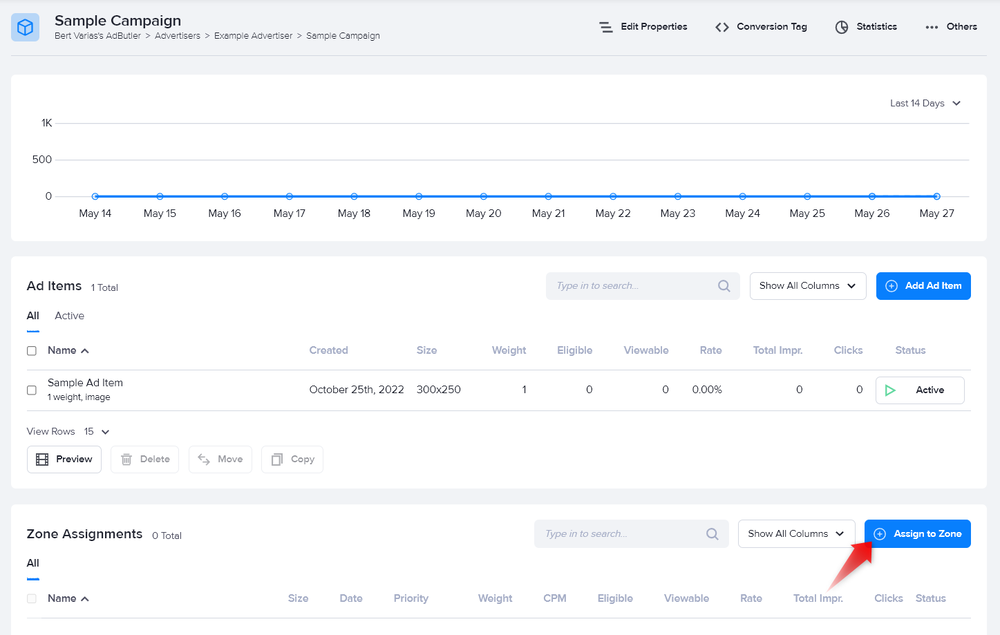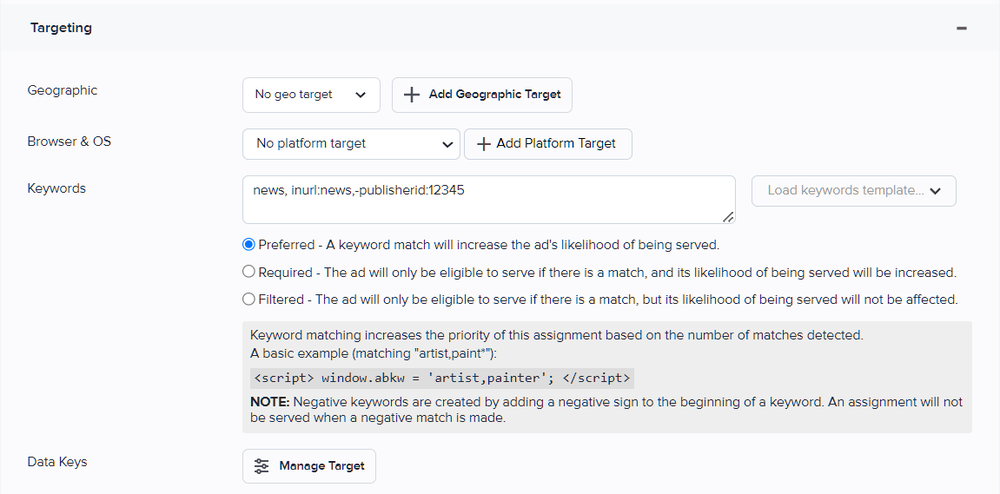Keyword targeting
Targets let you show different ads in the same zone for different users or pages in the publisher's site. With keyword targeting, you can serve the assigned campaign only on pages with certain URLs or words. You can also use keyword targeting to require specific publishers to be served, or to exclude them from being served certain ads.
You will learn:
- How keyword targeting works.
- About keyword syntax and special keyword characters.
- How to assign keywords to a campaign.
- How to enable keyword targeting in the publisher's website.
- How to check if a keyword is properly set in the publisher's website.
- How to enable keyword targeting in email ads.
How keyword targeting works
For websites, whenever an AdButler zone tag is loaded in a page, the global JavaScript variable window.abkw is recorded as the keyword for that page. This is the variable to which keywords are assigned. In most cases, window.abkw won't be set to any keyword and AdButler will ignore it.
For emails, the keyword variable is kw. You must manually include this variable in the email zone tag along with the keyword to enable targeting in email ads.
If window.abkw or kw is set to a keyword, AdButler will then look at the assigned ads or campaigns in the zone to see if any of them match the keyword.
- If an ad item or a campaign's keyword is set to Preferred, it will be prioritized and be displayed above other ad items or campaigns that are not specifically targeted by keywords. Even if the keyword is not detected, there is still a chance for the ad to appear in that placement.
- If the keyword is Required, the ad item or campaign will be prioritized and have a chance to be served only if the keyword matches.
- If a keyword is Filtered, the ad item or campaign will have a chance to be served only if the keyword matches, but its likelihood of being served does not increase.
window.abkw when adding the zone tag into the publisher site. If the publisher site has variables for keywords, make sure to assign the appropriate variable to window.abkw See Enabling keyword targeting in the publisher's website.Keyword syntax and special characters
Keywords and keyword macros
- string: this is the word or phrase that you want to be in the publisher's page, e.g.
news. inurl:: a keyword macro that you use to target a string in the publisher's URL instead of within the page. Do not add a space between the colon and the string, e.g.inurl:news.publisherid:: a keyword macro that you use to target a specific publisher based on the publisher ID. Do not add a space between the colon and the ID, e.g.publisherid:12345.
Special characters
Aside from the string itself or the keyword macros, there are special characters that extend the features of keyword targeting, such as letting you search for multiple keywords at once, or excluding the matching page or publisher from being served.
* |
A wildcard character. For example, *ews will match any four letter word within the page that ends in "ews". |
- |
Specifies that a keyword is a negative match. While a regular match gives an ad a chance to be served, a negative match prevents the ad from appearing at all. This works with all keyword types. Do not add a space between - and the keyword. For example, -publisherid:12345 tells AdButler not to serve the ad or campaign to that publisher. |
, |
Allows you to specify multiple keywords. This works with all keyword types, but it is an OR operator. In other words, AdButler will consider a match even if only one or some of the keywords match. Do not add a space between keywords and commas. For example news,inurl:news,-publisherid:12345 tells AdButler to serve the ad to a page with the word "news" within the page, a page with "news" in the URL, OR to sites that are not owned by publisher 12345. |
+ |
Makes a keyword a required match. If the keyword is not detected, the ad will not be served. Do not add a space between + and the keyword. For example, +inurl:news will serve the ad only to pages with "news" in their URL.NOTE: This works only with the Preferred keyword targeting option |
() |
Groups keywords together. This lets you apply other special characters to groups of keywords as if they were individual keywords. This is an AND operator. For example, +(news,inurl:news),-(publisherid:12345) tells AdButler to serve the ad only to pages with a match of news or inurl:news, AND not owned by publisher 12345.NOTE: This works only with the Preferred keyword targeting option |
| \ | Specifies that the succeeding hyphen (-) or plus sign (+) is part of a keyword and not a special character. You must add this character if your keyword or list of keywords contains an AND operator (), even if the - or + is outside the operator.For example, instead of typing +(hotels,self-catering holiday homes), you should instead type +(hotels,self\-catering holiday homes).Instead of typing +(hotels,condos),self-catering holiday homes, you should instead type +(hotels,condos),self\-catering holiday homes. |
Assigning keywords to a campaign

- Go to the relevant campaign's dashboard (Advertisers > Your Advertiser > Your Campaign).
- Click Assign to Zone on the top right of the Zone Assignments table. A list of eligible zones will appear.
- Select a zone to which the campaign will be assigned. The Assignment Details page will appear.
- Select a serve method. The rest of the settings will appear.
- Set the initial settings as needed, then scroll down to the bottom of the page. Click Targeting to expand its settings.

- Enter your keyword or keywords. Be sure to use the correct syntax.
- Select a keyword targeting option:
* Preferred - If the assigned keyword matches the one in your zone tag or matches the keyword in the script of the page, the ad item or campaign will receive prioritized placement and be displayed above other ad items or campaigns that are not specifically targeted by keywords. Even if the keyword is not detected, there is still a chance for the ad to appear in that placement.
Required - The ad item or campaign will be moved to the front of the line for prioritized placement. However, uunlike Preferred, if the keyword is not detected the ad item or campaign will not be served.
Filtered - The ad item or campaign will appear only if there's a keyword match. However, unlike Required, it will not receive prioritized placement and will be in rotation with other ad items that are also targeted to the same page.
- Click Save.
You can now enable keyword targeting in your publisher's website.
Enabling keyword targeting in the publisher's website
These instructions show the most common way to set keywords in the publisher's website.
- Open the source code for the web page header.
- Add this snippet to the header, replacing
'YOUR_KEYWORD'with the keyword for the page. Be sure to enclose the keyword in single quotes.
<script>
window.abkw = 'YOUR_KEYWORD';
</script>
window.abkw = 'artist,painter,illustrator';- Save your changes.
Checking if a keyword is enabled in the publisher's website
- Open the page in a browser.
- Right-click the page then select the inspect option. The browser inspector will open.
- Click on Console.
- Search for
window.abkwwithin the console. If it appears and has the right keyword, then the keyword was properly set.
Enabling keyword targeting in email ads
- Go to the dashboard of the relevant email zone (Publishers > Your Publisher > Your Email Zone).
- Click Get Zone Tags in the right menu. The Zone Tags window will appear.
- Enter the Email User ID Macro (EUID).
- Enter a click macro (optional).
- Select the protocol.
- Click Generate Tag.
- Copy the tag and paste it into a text editor. Add
&kw=YOUR.KEYWORDafter your EUID in theimg srctag, replacingYOUR.KEYWORDwith the keyword for the email. Do not add quotation marks to the keyword. For example:
<!-- Example Email Zone [email] -->
<a href="https://servedbyadbutler.com/go2/;ID=181442;size=300x250;setID=585818;uid=123-123;" target="_blank"><img src="https://servedbyadbutler.com/e061c2b60/img-api/O0lEPTE4MTQ0MjtzaXplPTMwMHgyNTA7c2V0SUQ9NTg1ODE4O3R5cGU9aW1n/?uid=123-123&kw=YOUR.KEYWORD" width="300" height="250"></a>
- Log in to your admin dashboard in your email provider and create a new email template.
- Look for the field in the template where HTML code is added. Paste the zone tag into that section.
- Save the template.